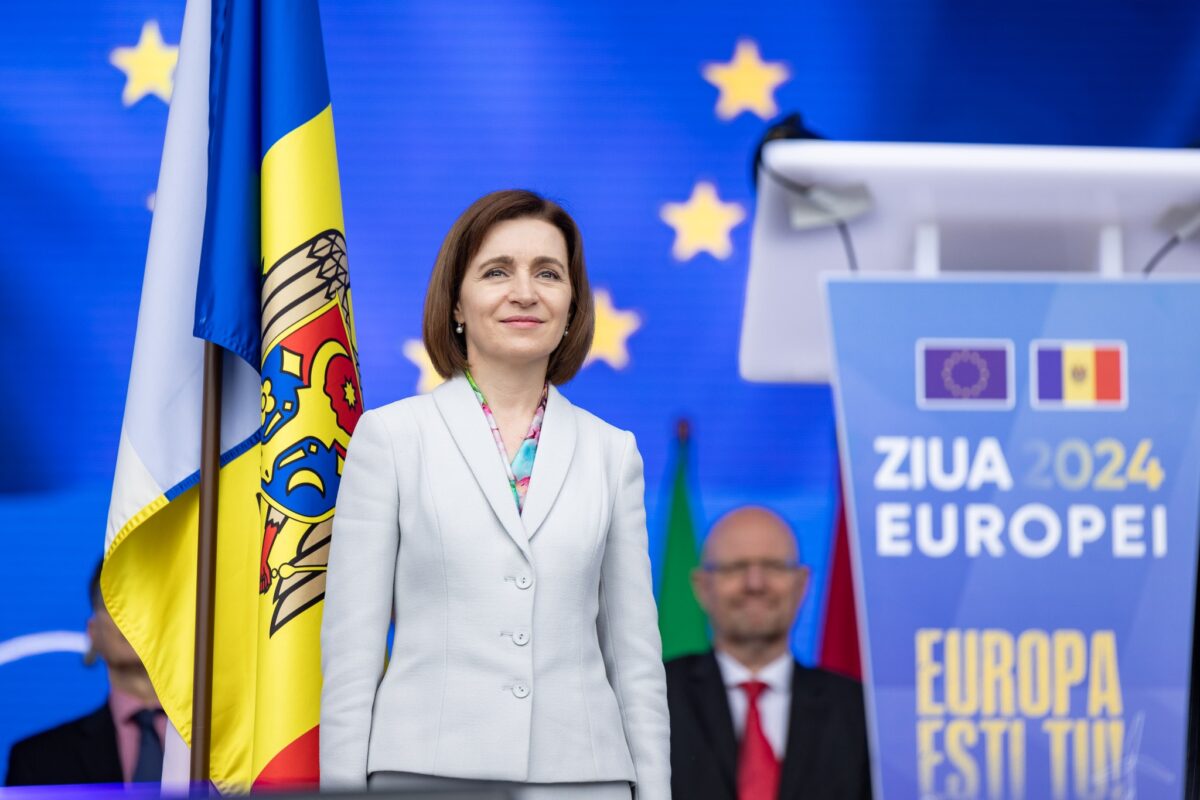A chaotic scene broke out in the early morning of June 11 at Chișinău’s International Airport. Several Moldovan citizens—traveling back from Moscow after a meeting of the pro-Russian ‘Victory’ opposition coalition—were searched by police officers. The travellers were held for several hours, and some protested loudly, while a tired 4am crowd watched, eager to be on its way home.
Far from being anecdotal, this tumultuous scene is quite symptomatic of Moldova’s boiling political landscape. As October’s presidential election and a referendum on EU accession draw closer, a weaponless war is raging between pro-EU President Maia Sandu and pro-Russian opposition parties. The latter are accused of engaging in massive propaganda and disinformation campaigns but say they’re being censored and repressed by the authorities. An unofficial electoral campaign in full swing.
Sandu announced months ago that she will run for a second term—and she has a good chance of winning, with polls showing that she will take around 30 per cent of votes in the first round of the election. The pro-Russian opposition meanwhile still lacks a clear candidate.
One thing is certain, however: whoever Sandu’s main opponent will be, he’ll likely be backed by Moscow. The country’s second and third most popular politicians, former president and leader of the Socialist party (PSRM) Igor Dodon, and fugitive oligarch Ilan Shor, both have close ties to Russia and Vladimir Putin. But while their anti-Western, pro-Russian rhetoric is similar, they have long been seen as political rivals.
Moscow’s candidate
But could this change? And how would a potential alliance of the opposition impact election outcomes? The idea of a common opposition candidate has been voiced for several weeks. While members of Ilan Shor’s Victory block haven’t participated in either of two meetings aimed at discussing potential options, one of Shor’s leading proxies in Moldova, Marina Tauber, said in April that she doesn’t “exclude” the possibility of a common candidate.
Socialist MP Grigore Novak, however, says that Ilan Shor’s team was “never” part of the negotiations and that if a common candidate were to be found, the Victory block wouldn’t fall under its umbrella.
There are reasons to think things are still quite murky behind the scenes. “We saw PSRM and Shor colliding on several occasions. Their relationship is clear: they are against the referendum, they both promote fake news propaganda and don’t condemn Russia’s invasion of Ukraine,” says Maia Sandu’s chief of staff, Adrian Baluțel.
But publicly, the PSRM has distanced itself from Ilan Shor, sentenced to 15 years in a million-dollar bank fraud case. He is also accused of funnelling Russian money into Moldova to fund party activities and bribe voters.
In April, the authorities confiscated over one million US dollars after searching the travellers who participated in the launch of his Victory block in Russia. Shor’s first party, Șor, was dissolved by the Constitutional Court last year after it was accused of trying to destabilise the country in collusion with Russian intelligence agencies.
“We are a classical party, we use different methods,” says PSRM’s Grigore Novak as he sits in his beige-walled office, surrounded by Chinese decorations and photographs of Vladimir Putin and leaders from Azerbaijan.
New favourites
But Socialist leader Igor Dodon is currently also facing trial. He’s charged with abuse of authority in the interests of an organised criminal group. And the Russian war in Ukraine has put him in a delicate position because of his longstanding friendship with Putin. But while the ties between the Kremlin and the PSRM still run deep, Russian support for the party has decreased over the past four years, according to political analyst Victor Ciobanu.
“When Dodon lost the last election to Maia Sandu, Russia decided to change its favourite, which is now Ilan Shor. They saw that he was more efficient. It’s also cheaper than going through an established political party structure such as the PSRM. And the socialists are frustrated by this,” Ciobanu explains.
A small country located between Romania and Ukraine, Moldova’s political squabbles may, at first, seem of little interest. But the truth is that what happens in the upcoming elections could set a strong precedent. After all, Moldova is not the only country targeted by propaganda furthering Russia’s agenda.
But trying to contain Russian influence is no easy task, and money is not the only vector of the Kremlin’s interests abroad. Several hundred thousand Moldovan citizens are Russian speakers and consume media and entertainment in Russian, despite Romanian being the official language taught in most schools.
In some regions, Soviet ideology remains engrained, and nostalgia from the Soviet era is propagated on TV and through local politicians. This has led to polarised opinions on whether Moldova should join the EU.
Presidential elections ‘not the main target’
In December, the European Commission gave its green light to start accession talks with both Moldova and Ukraine. Talks formally began this week. Since then, campaigns criticising the EU and discrediting Sandu have only grown louder. And it’s no coincidence. On October 20, Moldovan citizens will not only choose their next president: they’ll also be asked to participate in a referendum to say if they favour Moldova joining the EU. This is something Russia is actively trying to prevent, pouring millions of dollars into the country.
“This referendum, together with the 2025 parliamentary elections, is the main target for the Kremlin. Not the presidential election,” adds Ciobanu. For him, a common pro-Russian presidential candidate was never a hypothesis. “To make the referendum fail, it’s much more convenient for the Kremlin to have several candidates, who take advantage of the campaign period and airtime to say that we shouldn’t join the EU,” he explains.
For the Moldovan government, the success of the referendum would mean increased legitimacy for moving forward with negotiations at the EU level. It would also make it less likely for future leaders and governments to divert Moldova from its path towards EU accession. Pro-Russian parties could have a chance of winning next year’s parliamentary elections. “The referendum results will set in stone the will of the people, and that will be very hard to ignore by anyone who will be in future parliaments. That’s why it’s important to make the referendum as inclusive as possible,” says Adrian Baluțel.
According to the latest estimates, over 55 per cent of Moldovans plan to vote “yes” in the referendum. However, the polls don’t usually include Moldovans living abroad, who typically skew the results towards more Western policies.
‘Agents of war’
To tip the balance, pro-Russian figures are spreading coordinated narratives to reach as many citizens as possible. The objective is clear: generate fear about Moldova’s proximity with the West.
“In the upcoming weeks and months, pro-Russian parties, with support from outside, will use any legal and illegal means at their disposal to distort the information about the EU and to trap people into believing fake information about it. That’s the biggest danger for the referendum so far,” adds Baluțel.
One recent strategy includes depicting the EU and the United States as agents of war. This has been widely documented in a report recently published by the NGO WatchDog.
“The public is being inoculated with the idea that a pro-EU vote is a pro-war vote and that boycotting the referendum is a vote for peace,” reads the NGO’s report. The organisation monitored that, over a 15-day span, Igor Dodon, Ilan Shor, as well as former Prime Minister Ion Chicu, former regional governor of Gagauzia Irina Vlah, and Russian foreign ministry spokesperson Maria Zakharova, have all propagated this viewpoint.
Accusing Maia Sandu of pulling her country into war while failing to denounce Russia’s actions in Ukraine may seem surprising at first. WatchDog’s analysts concluded: “Some might say this is the peak of hypocrisy, but it’s just a method used in the hybrid war. The agitators of the campaigns aimed at influencing Moldovan public opinion follow to the letter the methods of Nazi propaganda: ‘a lie, as big as it may be, will be believed if it’s repeated a sufficient number of times’.”
Cutting the ground from under Russia’s feet
The Moldovan government, backed by its Western allies, is actively trying to fight back in this hybrid war. This includes sanctioning and forbidding parties affiliated with Russia and closing media outlets spreading Russian propaganda.
A law on state treason was recently modified and could potentially lead to members of the Victory block being sanctioned for their meeting in Moscow. And some parties could soon be prohibited, following the pattern of the Șor party in 2023.
How efficient these methods will be remains to be seen. “The Victory block can be rebranded within 24 hours. We have around 80 parties, it’s very easy to buy one of them,” says Victor Ciobanu. As steps to cut the ground from under Russia’s feet grow more intense, Maia Sandu is also facing scrutiny internally and abroad, including from some Western organisations. While the government denies going against any democratic principles, it has been criticised for the new treason law, the closure of media outlets without a court decision or some limitations on freedom of expression.
Many in Moldova, however, see this as a necessary measure to prevent pro-Russian politicians from taking the reins.
“We’re in a hybrid war, and in a war, there can be some censorship,” Ciobanu admits. “I don’t want to wake up in 2025 and find myself with a parliament that tells me that were better off in the Soviet Union.”







